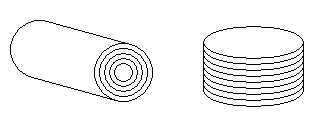
Version 1 I made as similar as possible in appearance to the Japanese machines I saw on YouTube. I envisioned a sliced-open metal drum with the gear motor and rotisserie on that axle. The pipe in the back is a gas starter pipe like those in fireplaces. Huh. I forgot that I had originally wanted gas heat.

The next version was very similar, but only moved on one axis. In retrospect, this is really worse than the first draft, because it has to slide and makes more moving parts. There's no gas pipe shown, but I'm sure I was still thinking gas heat at this stage.
Then, somehow, I got obsessed with this shape:

I started making plans for a hollow trapezoidal prism with electric heaters on the inside of the three rectangular faces. In smaller models, this could be picked up and placed over the rotisserie, which would mean no axle needed.

This was also a dumb move, just because the shape is so awful. Now, my current line of thinking is a rectangular prism and propane burner.

(Not shown: Rails to hold the rotisserie bar in place) One day, that will surely look hella stupid too.

